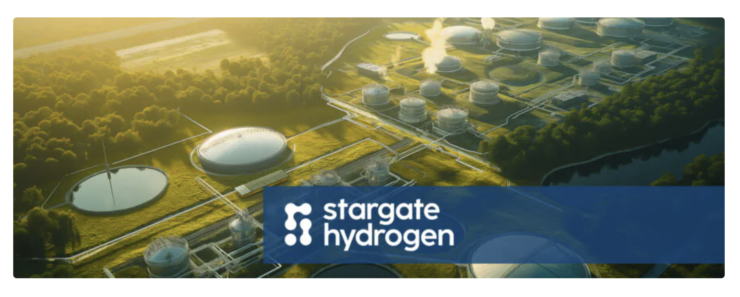Stargate Hydrogen – Understanding Green Hydrogen Systems: The Mighty Hydrogen for a Carbon-Free Tomorrow.
In the quest for a more sustainable and environmentally responsible future, businesses are increasingly turning to innovative solutions to reduce their carbon footprint. As carbon emissions and climate change continue to pose serious challenges, green hydrogen has emerged as a promising option for companies seeking to decarbonize their operations. For decision-makers in the industry, understanding the intricacies of Green Hydrogen Systems is crucial.
In this comprehensive guide, we will explore the details of how Green Hydrogen Systems work, their main components and how they collaborate to produce green hydrogen—a versatile, clean, and sustainable energy source.
The Imperative for Green Hydrogen Systems
Before we dive into the inner workings of Green Hydrogen Systems, it’s essential to comprehend the driving force behind this revolutionary technology. The global imperative to reduce carbon emissions and transition to a greener future is now more pressing than ever. Green hydrogen, often touted as the “fuel of the future,” offers a promising pathway to significantly curbing greenhouse gas emissions across various industries.
🔥 What about we co-host a webinar? Let's educate, captivate, and convert the hydrogen economy!
Hydrogen Central is the global go-to online magazine for the hydrogen economy, we can help you host impactful webinars that become a global reference on your topic and are an evergreen source of leads. Click here to request more details
Green hydrogen is produced through a process known as electrolysis, where renewable energy sources, such as wind or solar power, are harnessed to split water into its constituent elements: hydrogen and oxygen. Unlike traditional hydrogen production methods, such as steam methane reforming (SMR), green hydrogen production does not release carbon dioxide into the atmosphere, making it an eco-friendly alternative.
The Anatomy of Green Hydrogen Systems
Green Hydrogen Systems comprises several essential components and processes that work in harmony to generate high-purity hydrogen with minimal environmental impact. To gain a comprehensive understanding of this system, let’s explore each component in detail:
The Electrolyser Stack
At the heart of Green Hydrogen Systems is the electrolyser Stack, an intricate piece of equipment that drives the electrolysis process. Electrolysers come in various types, including proton exchange membrane (PEM) electrolysers and alkaline electrolysers, each with distinct advantages and applications.
The Electrolyser takes the incoming electrical energy and uses it to drive the splitting of water into hydrogen and oxygen. In this process, the electrical energy is converted into chemical energy stored in the form of high-purity hydrogen gas.
Alkaline Electrolyser
Alkaline electrolysers are robust and cost-effective solutions for large-scale hydrogen production. They employ a liquid alkaline electrolyte solution, typically potassium hydroxide, to facilitate the separation of hydrogen and oxygen. While they may have slightly lower efficiency compared to PEM electrolysers, alkaline electrolysers excel in applications where large quantities of green hydrogen are required.
You can read more about the different types of hydrogen production on our article: Green Hydrogen Production: A Sustainable Energy Game-Changer
The Power Source
The primary source of power for Green Hydrogen Systems is renewable energy. Solar panels or wind turbines are commonly used to generate electricity, which is then directed to the electrolyser for the electrolysis process. The use of renewable energy ensures that the hydrogen production process remains environmentally friendly, as it eliminates the greenhouse gas emissions associated with fossil fuel-based electricity generation.
The Water Supply System
A steady supply of clean water is crucial for the electrolysis process. Water is typically sourced from local water supplies or can be recycled and purified for use in the system. Although water purification accounts only for a fraction of the electrolyser system’s energy consumption, electrolysers do require very high-purity water to avoid degradation of the system. The water supply system ensures that the electrolyser operates with high efficiency and minimal water wastage.
The Hydrogen Compressor
Once hydrogen is generated through the electrolysis process, it needs to be compressed to the desired pressure for use, storage and transport. Hydrogen compression equipment is employed to achieve this, and it plays a crucial role in optimizing the efficiency and safety of the system. Higher compression requires more energy. However, it also enables more compact storage and ease of transportation.
The H2 Gas Purification
To ensure the purity of the produced hydrogen, gas purification equipment is integrated into the system. This step removes impurities, such as oxygen and moisture, to meet the stringent purity requirements of different industries. Before hydrogen is used, it undergoes gas purification to remove any impurities, ensuring it meets the stringent purity requirements of the target application.
The Monitoring and Control Systems
To guarantee the efficient operation and safety of Green Hydrogen Systems, sophisticated monitoring and control systems are essential. These systems oversee various parameters, such as gas purity, pressure, and flow rates, and can respond to deviations from set conditions in real-time. Throughout the entire process, monitoring and control systems ensure the optimal operation of the Green Hydrogen System. These systems continuously assess and regulate various parameters to maintain safety and efficiency.
The Hydrogen Storage
Hydrogen, being a highly flammable gas, requires safe and reliable storage solutions. Green Hydrogen Systems utilize various storage methods, including gaseous and liquid hydrogen storage and metal hydride storage,. The choice of storage method depends on factors like available space, safety considerations, and the specific needs of the application. The compressed hydrogen is stored in a safe and secure manner, ensuring it remains readily available for various applications.
The Distribution and Utilization
Green hydrogen can be transported to end-users through pipelines, cylinders, or as a liquid. Its versatile nature allows it to be used in various applications, including industrial processes, transportation, and power generation. Executives seeking to reduce their carbon emissions can explore the adoption of green hydrogen as a clean energy source to fuel their operations. The purified hydrogen is transported to end-users through appropriate channels, such as pipelines or cylinders, and can be utilized in a wide range of applications. For instance, it can be used as a clean fuel for hydrogen-powered vehicles, as a feedstock in industrial processes, or for power generation.
The Symbiosis of Green Hydrogen Systems
The synergy between these components allows for the production of green hydrogen with minimal environmental impact. This environmentally responsible approach not only reduces carbon emissions but also offers a sustainable energy solution for companies looking to transition to a greener and more sustainable future.
Benefits of Green Hydrogen Systems
Now that we have a firm grasp of how Green Hydrogen Systems operate, let’s explore the numerous benefits they offer to companies seeking to reduce their carbon emissions and embrace sustainability taking into consideration the challenges that decision-makers should be aware of when implementing this technology:
Green hydrogen production is inherently carbon-neutral. The process generates no direct greenhouse gas emissions, making it an ideal solution for companies aiming to reduce their carbon footprint. This aligns with global sustainability goals and positions companies as environmentally responsible entities.
Green hydrogen can be used across a broad spectrum of industries and applications. Its versatility extends to sectors such as transportation, industrial processes, power generation, and more. Executives and decision-makers can explore its integration into their operations, regardless of their industry. The success of Green Hydrogen Systems depends on a reliable supply of renewable energy. Companies must assess the availability and consistency of their chosen energy source to ensure uninterrupted hydrogen production.
As the technology and infrastructure for green hydrogen mature, the cost of production is expected to decrease. This makes green hydrogen an increasingly economically viable choice for companies looking to reduce their carbon emissions while maintaining operational efficiency.
The initial capital expenditure for establishing Green Hydrogen Systems can be substantial, especially for large-scale installations. Companies must carefully evaluate the return on investment and consider long-term benefits when making this commitment.
Green hydrogen serves as an efficient means of energy storage. Excess electricity generated from renewable sources can be converted into hydrogen during periods of surplus, and this hydrogen can be stored for later use, bridging the intermittent nature of renewable energy sources. Proper hydrogen storage and transportation infrastructure must be in place to ensure the efficient use of green hydrogen. Companies should plan for the logistics of handling and distributing this gas.
With evolving environmental regulations and incentives, companies that embrace this sustainable energy solution can take advantage of incentives and subsidies aimed at reducing carbon emissions. Adhering to evolving regulations and standards related to hydrogen production, storage, and transportation is vital. Keeping up with compliance requirements is essential to avoid any regulatory issues.
Green Hydrogen Systems can be deployed in decentralized settings, enabling companies to generate their own hydrogen on-site. This approach can reduce transmission and distribution losses, increasing overall energy efficiency.
Diversifying energy sources with green hydrogen can enhance energy security for businesses. The ability to generate hydrogen onsite provides a reliable and independent energy source, reducing vulnerability to disruptions in traditional energy supplies.
And finally, positioning your company as an early adopter of green hydrogen can confer a competitive advantage. It not only demonstrates a commitment to sustainability but also appeals to eco-conscious consumers and investors.
Main Takeaways
As the global community faces increasing pressure to reduce carbon emissions and combat climate change, green hydrogen emerges as a powerful solution for companies seeking to align their operations with sustainable practices. Green Hydrogen Systems represent a sophisticated integration of technology, renewable energy, and efficient processes, providing a sustainable and versatile energy source that can be tailored to the needs of various industries.
By understanding the inner workings and benefits of Green Hydrogen Systems, executives and department heads are better equipped to make informed decisions about integrating this technology into their operations. While there are challenges and considerations, the long-term environmental and economic advantages of green hydrogen make it a compelling choice for companies committed to a greener and more sustainable tomorrow.
In the journey toward a greener tomorrow, the adoption of Green Hydrogen Systems marks a significant step forward. By reducing carbon emissions, enhancing energy security, and embracing environmental responsibility, companies can position themselves as leaders in the pursuit of a more sustainable future, ultimately benefitting their bottom line while preserving the planet for generations to come.
READ the latest news shaping the hydrogen market at Hydrogen Central
Stargate Hydrogen – Understanding Green Hydrogen Systems: The Mighty Hydrogen for a Carbon-Free Tomorrow. source








